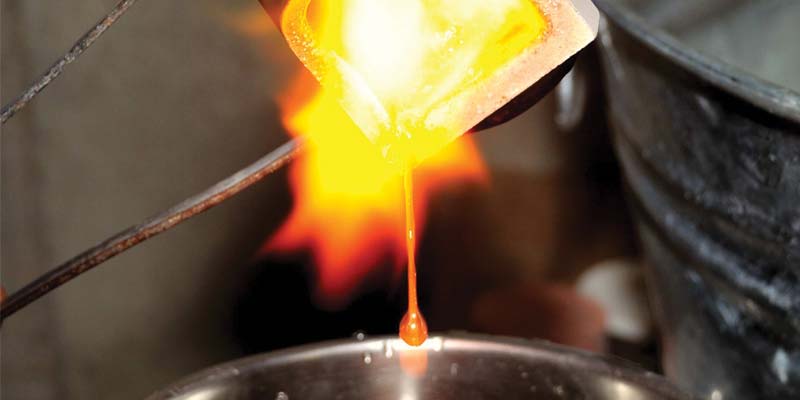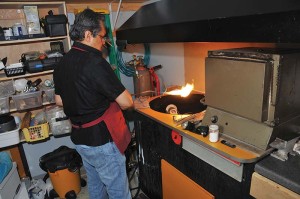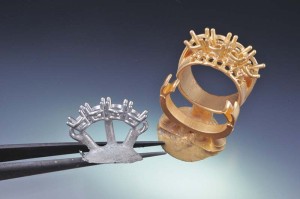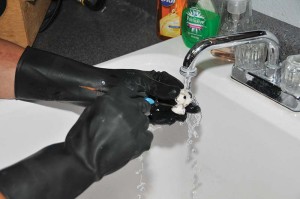To cast or not to cast: Is casting in-house for you?
by charlene_voisin | August 1, 2015 9:00 am
By Gary Dawson
 [1]
[1]
The torch roars as gold begins to shimmer in the crucible and solid metal slumps into a liquid puddle. With the blur of an accelerating centrifuge, molten metal disappears into the mould cavity. There, nearly instantly and unseen, it is transformed into either a new creation or a porous blob of trouble.Ӭ
One of the regular occurrences in my shop I try to understand is the lost-wax casting process. Just as casting can inspire a feeling of control and accomplishment (a.k.a. ‘the magic’), it can just as easily provoke a sense of utter frustration (a.k.a. ‘the misery’). The question for many small shop owners is how much of that magic and/or mystery are they willing to tolerate on their own. Is in-house casting worth the price of the investment or are jewellers and designers better off relying on the expertise of subcontractors? If you’re in that situation, here are a few factors you may not yet have encountered.
Casting considerations
 [2]
[2]For some, the first thought may be about equipment cost, which is a valid concern. Overall, the cost of the equipment necessary to cast varies, depending on your production requirements. One might want to consider the words of Igor Shersher of Platina, a full-service trade shop in New York City. “Buy in cheaply, you sacrifice quality, get in expensively, and you can’t afford it,” he says. Since casting equipment prices are readily available by perusing the supply catalogues likely lying around your shop, I won’t address this issue specifically. One of the most important points I want to convey in this article is that consideration of the process may require factoring in many additional parameters.
For example, consider the cost of installation. Does your infrastructure easily accommodate a kiln, ventilation system, wax preparation, and investing? Another great question that may be tangential to cost is training. Is your shop prepared with enough expertise to cast both successfully and efficiently? If the expertise is in-house already, the decision may be simpler than if either you or an employee will need lengthy training. The apparent simplicity of the casting process can be misleading—it is an incredibly nuanced field of expertise, and each year we learn more about how the process really works, both to achieve superior casting success and to precipitate failure. One hard truth is casting problems often don’t show up until the final finishing process. Micro-porosity is one example. Poorly formed crystalline structure—created by anything from contaminants to improper flask temperature—is sometimes hard to trouble-shoot and often impossible to resolve without remaking the piece.
In speaking with other casters around Canada and the United States, I find control seems to be one of the main motivations for casting in a small shop. By that, I mean control of the entire production process, of the time element involved in production, of the metal, and over one’s inspired designs. All are mentioned when casters speak about why they cast.
 [3]
[3]In my own work, comprised mostly of custom design, I try to embrace the idea of sole-authorship when possible. As such, I can relate to the desire to maintain direct involvement in each step it takes to make one of my custom pieces. This seems to be a subjective decision and one each designer must make for themselves.
The element of time it takes in finishing a project, however, may be more objective and affected by both the location of your business and the nature of your work. Master goldsmith Dino Giannetti of Toronto’s 18Karat, says he chooses not to cast his projects. “I can drop off my carved waxes or grown designs one day and pick them up the next here in downtown Toronto.” Giannetti also makes a good point when he mentions the variety of metals with which he works and how that affects his decision. He may need several castings in any given production cycle, “With one of them being 14-karat yellow gold, one 18-karat yellow gold, one 14-karat rose gold, and several platinum, does it make any sense for me to maintain a separate system for each of these metals? For me, it makes more sense to let the experts in each of these metals do the work for me.”
One could also point out not all metals are easily castable with less-than-optimal equipment. It is one thing to cast gold alloys and quite another to cast palladium, for example. Casting most gold alloys can be accomplished to a high degree of success with a torch, kiln, and spring-loaded centrifuge. Palladium, however, requires induction melt, inert cover gas, and a vacuum-assisted centrifuge to cast successfully. In this case, even if you routinely cast gold in your shop, you will likely send out palladium castings to a trade shop set up for the process.
Mitigating metal costs
 [4]
[4]Some might correctly argue they can save money by doing their own casting, but there are several points to consider when factoring all the costs associated with casting beyond installation and training. One that can be easily overlooked is the cost of holding inventory. To clarify, I’m referring to keeping a reserve on hand of each metal one is prepared to cast. Holding inventory of gold, silver, or platinum alloys is costly when you consider that money could be working for you in other ways. Sometimes called ‘opportunity cost,’ this factor can be difficult to calculate precisely; however, if a hypothetical $10,000 one holds in casting alloys for the occasional casting job could be alternatively placed in inventory with very rapid turnover, it may make sense to closely evaluate how well your money is working for you.
That said, one way to mitigate the cost of holding precious metal inventory for casting is to make your own gold alloys. Many refineries provide ‘master alloys,’ which contain all the components of a given jewellery alloy, minus the gold. These are fairly inexpensive by the ounce, so casting any colour or karat of gold may only require holding an ounce or two of pure gold at a time. The process is simple enough such that if you are already casting—or going to cast—you will be able to blend your own gold alloys. This tactic may only really make sense for gold alloys, though. Silver is relatively inexpensive, so holding a few ounces for eventual casting would represent about $50 in capital. And it probably makes sense to purchase platinum pre-alloyed, as the metals often used as an alloy component, other than cobalt, are fairly expensive, too.
We’ve seen how location in relation to proximity to casting services may play into your decision to cast in your shop. Location in terms of shop space itself may also be a factor. If you have a rather small space, or rental cost-per-square foot is high, the dedication of space to the process may make it impractical to cast in-house. For example, costs per square metre can normally be measured in the high hundreds of dollars in a large city, whereas space in a small community may be only in the tens of dollars per square metre, greatly influencing one’s options.
A matter of time
 [5]
[5]Casting involves many steps: spruing, investing, burnout (which requires venting), and actual casting, each either needing separate space or involving a cleanup and set-up routine whenever the process is implemented. Time involved in the constant space shuffle can become overbearing if one considers it a form of currency. A good argument can be made that it is much easier to track an expense if you pay cash for it. That is, it may be easier to track and control overhead when one is laying out capital, rather than personal time on a project. My own experience confirms personal time tends to get overlooked in the overhead equation.
Tom Wright of Wright’s Jewelers in Lincoln, Neb., has “pointed views” on the topic of casting, as he puts it. “I do most of my casting in-shop because I primarily want to offer unusual or different things in my work,” he says. “I have no intent to re-invent the wheel and I use carving and casting to set myself apart from the competition, to make my shop special.” Therefore, he usually casts most objects as single castings. At first during our conversation, he mentioned casting gave him a “competitive edge,” but after a brief pause, he adjusted that thought to, “By carving and casting, I don’t really have to compete, since you can’t buy my designs anywhere else in the world.” He does send casting out, however, when he has a production situation. One example of this occurred in a recent Christmas season when he was asked to produce 50 of one item. After casting the original, he sent out the remainder of the production to free up his time for other projects.
Factoring sentimentally into the equation
 [6]
[6]Tom brought up one other reason to cast that I could personally relate to very well: the issue of recycling gold. Whether for sentimental reasons or for budget, I often recast old gold for clients. Not all popular jewellery metals are easily recyclable and I am particular about what I recycle. I also have a strict policy about not quality-marking any alloy for which I cannot personally vouch. Additionally, I always warn the client that in recycling old gold, I cannot guarantee finish characteristics. Many times though, recycling a client’s unused gold is a way to finalize a sale and there is usually little perceivable difference in the final quality of cast recycled gold and new alloy. Also, the sentimentality of having some portion of grandma’s old gold in a new wedding ring is an incalculable added-value to many clients. I’m reminded of one of the most touching moments in my 40 years as a goldsmith.
I was involved in the design and production of new wedding rings for an older couple. One of the first things they asked before they initiated the project was whether I could recycle their old wedding rings. They didn’t appear to be concerned about price and something seemed a little ‘special’ about their request. In my typically straightforward way, I asked why it was so important. They related to me they both had lost their first partners through death. While they were very much in love, they also both wanted to honour and give recognition to their first love. I was sincerely touched by the thought as they presented it. I suggested that not only would I be happy to recycle the old rings, I would let them watch the casting process if they desired. They were enthusiastic about the prospect and we set a date for them to come into the shop after-hours and watch me cast their flask.
When they arrived, I was not too surprised to see they had brought a bottle of champagne and a carefully prepared plate of cheese and crackers to my studio. Just before I began the melt to throw their flask, they asked me to pause for a moment while they said a simple prayer in observance of the special circumstances that had brought them together. I guess I’m sort of a romantic, but I had to wipe tears from my eyes as I melted their old lives into their new. Had I not been set up for casting, I never would have had that experience.
There are many factors involved in the decision to cast in a small shop environment and it may be difficult to effectively analyze the question in a manner that applies to every operation. Equipment costs, space, shipping, labour, and inventory may be tangible enough to quantify, but there are also intangibles, such as turnover time, level of service, and goodwill that are much more difficult to value. In the end, the final decision may be made on the basis of how much ‘magic’ you are willing to indulge.
 [7]Gary Dawson is owner of Gary Dawson Jewelry Designs, an online custom design operation that was once featured as a “Best of the Best” by Instore Magazine, as well as Dawson Distributions LLC, a supplier of CAD/CAM solutions for jewellers. Dawson has more than 40 years’ experience in creating designs that capture the personalities and stories of his customers, and he is a frequent contributor to MJSA Journal. He has also delivered seminars and presentations at numerous events, including AGTA GemFair, Portland Jewelry Symposium, and the Santa Fe Symposium on Jewelry Manufacturing Technology. Dawson can be reached via e-mail at gary@garydawsondesigns.com[8].
[7]Gary Dawson is owner of Gary Dawson Jewelry Designs, an online custom design operation that was once featured as a “Best of the Best” by Instore Magazine, as well as Dawson Distributions LLC, a supplier of CAD/CAM solutions for jewellers. Dawson has more than 40 years’ experience in creating designs that capture the personalities and stories of his customers, and he is a frequent contributor to MJSA Journal. He has also delivered seminars and presentations at numerous events, including AGTA GemFair, Portland Jewelry Symposium, and the Santa Fe Symposium on Jewelry Manufacturing Technology. Dawson can be reached via e-mail at gary@garydawsondesigns.com[8].
- [Image]: http://www.jewellerybusiness.com/wp-content/uploads/2015/11/PCPour.jpg
- [Image]: http://www.jewellerybusiness.com/wp-content/uploads/2015/11/DSC_9721.jpg
- [Image]: http://www.jewellerybusiness.com/wp-content/uploads/2015/11/Casting-Group-JPG.jpg
- [Image]: http://www.jewellerybusiness.com/wp-content/uploads/2015/11/DSC_9016.jpg
- [Image]: http://www.jewellerybusiness.com/wp-content/uploads/2015/11/DSC_9746.jpg
- [Image]: http://www.jewellerybusiness.com/wp-content/uploads/2015/11/DSC_9740.jpg
- [Image]: http://www.jewellerybusiness.com/wp-content/uploads/2015/11/Dawson.Gary-2-26-1520435.jpg
- gary@garydawsondesigns.com: mailto:gary@garydawsondesigns.com
Source URL: https://www.jewellerybusiness.com/features/to-cast-or-not-to-cast-is-casting-in-house-for-you/